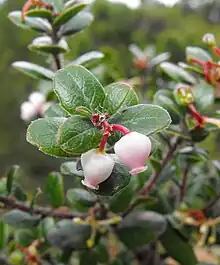| Arctostaphylos nummularia subsp. mendocinoensis | |
|---|---|
 | |
| Scientific classification | |
| Kingdom: | Plantae |
| Clade: | Tracheophytes |
| Clade: | Angiosperms |
| Clade: | Eudicots |
| Clade: | Asterids |
| Order: | Ericales |
| Family: | Ericaceae |
| Genus: | Arctostaphylos |
| Species: | |
| Subspecies: | A. n. subsp. mendocinoensis |
| Trinomial name | |
| Arctostaphylos nummularia subsp. mendocinoensis (P.V.Wells) V.T.Parker, M.C.Vasey & J.E.Keeley | |
| Synonyms[1] | |
| |
Arctostaphylos nummularia subsp. mendocinoensis, commonly known as pygmy manzanita, is a subspecies of manzanita. It is endemic to Mendocino County, California, where it is known from scattered occurrences in the pygmy forests near the coast.
Description
This is a small, mat-forming shrub growing in low mounds less than half a meter tall. It has red, shreddy bark and bristles along its smaller branches. The leaves are dark green, shiny, convex, and hairless, and rarely more than a centimeter long. The inflorescence is a dense cluster of urn-shaped flowers with four tiny lobes at the mouth. The fruit is a cylindrical drupe only a few millimeters long, containing four minute seeds.
References
- ↑ "Arctostaphylos nummularia subsp. mendocinoensis (P.V.Wells) V.T.Parker, M.C.Vasey & J.E.Keeley". Plants of the World Online. Royal Botanic Gardens, Kew. Retrieved 2022-04-29.
External links
This article is issued from Wikipedia. The text is licensed under Creative Commons - Attribution - Sharealike. Additional terms may apply for the media files.